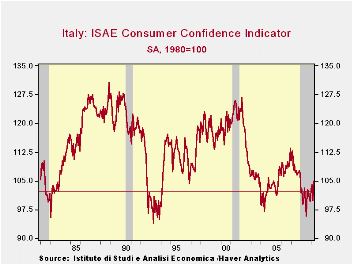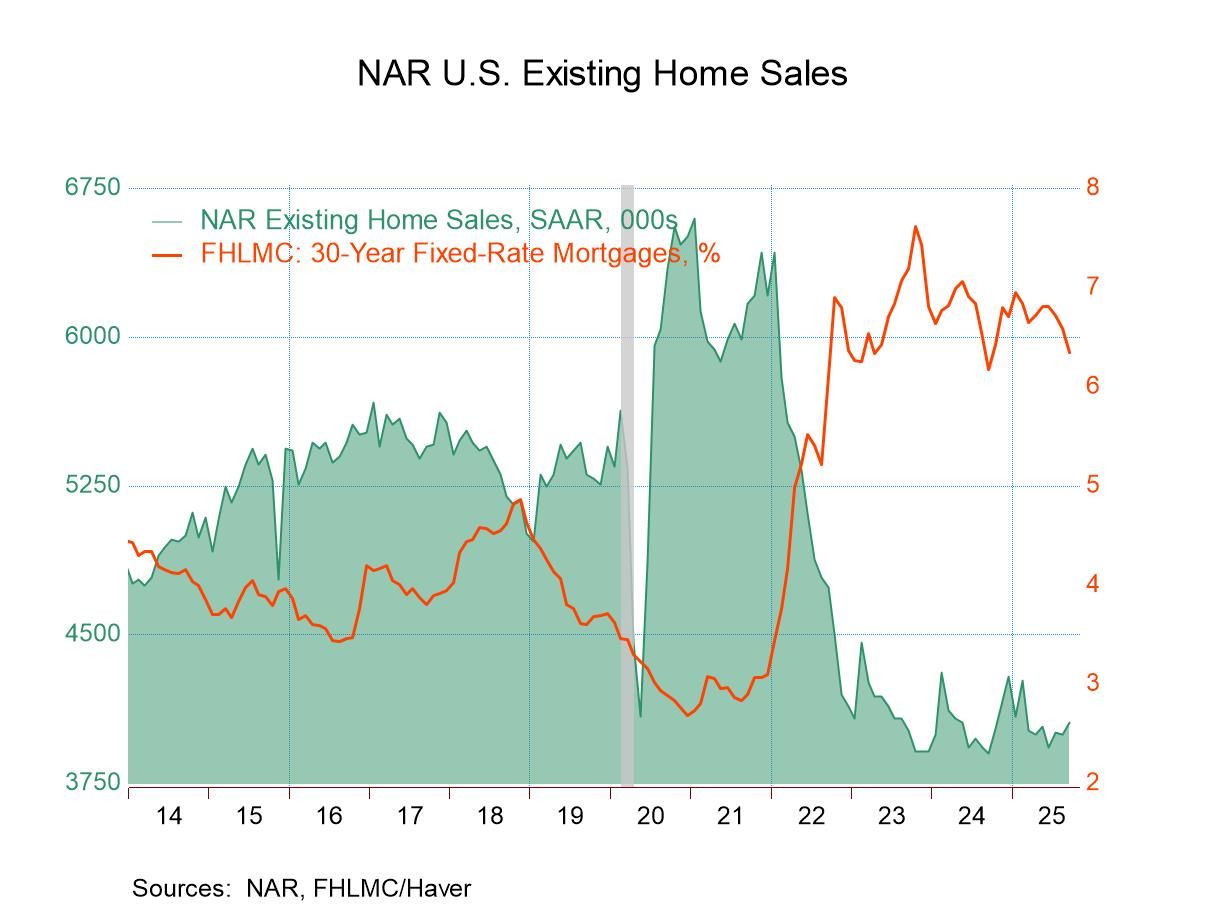 Global| Apr 27 2009
Global| Apr 27 2009Consumer Confidence Improves Sharply In Italy
Summary
The consumer confidence reading for Italy has been weak in this cycle but not quite as weak as it was in the previous two downturns in the early 1980s and early 1990s. Despite the bad press this business cycle keeps getting, in Italy [...]

The consumer confidence reading for Italy has been weak in
this cycle but not quite as weak as it was in the previous two
downturns in the early 1980s and early 1990s. Despite the bad press
this business cycle keeps getting, in Italy consumers have not
generally gotten as despondent as in the past two cycles nor have they
stayed as depressed for as long. That is probably against public
perceptions of this recession. Indeed, when I looked at these results I
double checked the spread sheet to see if I’d entered the dates
correctly – and I had. I was (I am!) surprised.
The chart on Italy’s consumer disposition is demonstrating a
clear uptrend, albeit in an oscillating fashion. This month’s reading
is the highest it has been Since December 2007. Moreover the 5.1 point
jump m/m is the fifth largest month-to-month jump in the index since
early 1992. The level of the index is still low but the jump is large.
The rise in the index is notable – especially given the size
of the rise - since Italian unemployment is expected to rise further
and consumer conditions are importantly a reflection of labor market
conditions. In Germany, too, the GfK index of consumer sentiment which
is a survey that projects readings for May shows consumer confidence
unchanged even though last week the leading German research institutes
came out with harsher assessments for the German economy for 2009. For
some reason- and Italian consumers are not alone in this – consumer
confidence is firming in the face of news that is in many ways
worsening.
The devil is in the details -- Italian consumers assess their
own mood with an index value of 104.9 which stands in the 33rd
percentile of its range of values back to January of 1992. The index is
weaker than this level only 27% of the time. So while these are low
readings they are not among the worst ever. The overall situation for
the past 12-months is evaluated as in the 58th percentile of its range,
ranking 121st out of 208 observations leaving it in the bottom 41st
percentile of its range. These statistics give the raw readings more
meaning by putting them in the context of the range of values and in
the context of rankings (frequency). We use ‘the percentile of the
range of value’ instead of ‘percent of mean’ since these components can
move in both positive and negative ranges: ‘percent of mean’ is just
not meaningful. Being in the 58th percentile means that although the
reading is above the mid point of its range it is still a moderate
reading: In fact it appears as an even lower reading in this case since
60% of the time the assessment is better than this. In this way we can
use percentage of range and ranking data to close in on what the
current reading really means
Over the next 12 months the reading for the overall situation
is, however, lower residing in the 20th percentile of its range and
being lower only 16% of the time. By this reading we see that
conditions have not been good and they are expected to get worse.
Still, in the last two recessions these metrics were even worse.
Unemployment for the next 12-months remains very bad, in the 75th
percentile of its range but with the fifth worst reading overall- a
ranking that puts it in the top 3% all time. That is to say that
unemployment fears have been worse than this only 3% of the time.
The household financial situation is in the 38th percentile
for the last 12 months and is expected to be in the 49th percentile of
range for the next 12-months. While 49th percentile is a ‘mid range’
reading that is misleading since the actual reading is lower than that
level only about 17 percent of the time. Apparently the range is wide
and skewed.
Perhaps the real reason Italian consumer sentiment is not so
bad is that Italians remain optimistic about the future, despite their
adverse sentiment. When they assess if it it’s the right time to make a
major purchase they put the current situation in the 40Th percentile of
its range. But when they assess the future they put it in the 95th
percentile of the range. So Italian consumers seem to admit that the
current situation is bad and may get worse in the period ahead. Yet
they remain optimistic that there will be a better time to buy things
in the coming months by a wide margin. Consumer optimism on the time to
make major purchases stands in marked contrast to assessments of the
overall situation for the next 12months as well as to fears of
unemployment and pressures on the household budget. We might be
encouraged to dismiss some of this optimism except we see it arising in
Germany as well. It’s a trend to watch for elsewhere.
| Italy ISAE Consumer Confidence | |||||||
|---|---|---|---|---|---|---|---|
| Since Jan 1992 Rank | |||||||
| Apr-09 | Mar-09 | Feb-09 | Jan-09 | Percentile | Rank | percentile | |
| Consumer Confidence | 104.9 | 99.8 | 104 | 102.6 | 33.4 | 151 | 27.4% |
| Last 12 months | |||||||
| OVERALL SITUATION | -74 | -84 | -78 | -75 | 58.4 | 121 | 41.8% |
| PRICE TRENDS | -43 | -45 | -38.5 | -33.5 | 4.1 | 207 | 0.5% |
| Next 12months | |||||||
| OVERALL SITUATION | -26 | -35 | -26 | -22 | 20.6 | 174 | 16.3% |
| PRICE TRENDS | 9.5 | 7 | 7.5 | 8.5 | 19.4 | 96 | 53.8% |
| UNEMPLOYMENT | 21 | 38 | 28 | 20 | 75.0 | 5 | 97.6% |
| HOUSEHOLD BUDGET | 1 | 5 | 8 | 4 | 17.0 | 198 | 4.8% |
| HOUSEHOLD FIN SITUATION | |||||||
| Last 12 months | -37 | -39 | -35 | -36 | 38.8 | 127 | 38.9% |
| Next12 months | -11 | -10 | -10 | -10 | 49.0 | 172 | 17.3% |
| HOUSEHOLD SAVINGS | |||||||
| Current | 60 | 69 | 66 | 59 | 72.7 | 13 | 93.8% |
| Future | -29 | -33 | -29 | -38 | 40.4 | 159 | 23.6% |
| MAJOR Purchases | |||||||
| Current | -41 | -43 | -39 | -42 | 40.4 | 99 | 52.4% |
| Future | 3 | 3 | 7 | 6 | 95.7 | 3 | 98.6% |
| Total number of months: 208 | |||||||
Robert Brusca
AuthorMore in Author Profile »Robert A. Brusca is Chief Economist of Fact and Opinion Economics, a consulting firm he founded in Manhattan. He has been an economist on Wall Street for over 25 years. He has visited central banking and large institutional clients in over 30 countries in his career as an economist. Mr. Brusca was a Divisional Research Chief at the Federal Reserve Bank of NY (Chief of the International Financial markets Division), a Fed Watcher at Irving Trust and Chief Economist at Nikko Securities International. He is widely quoted and appears in various media. Mr. Brusca holds an MA and Ph.D. in economics from Michigan State University and a BA in Economics from the University of Michigan. His research pursues his strong interests in non aligned policy economics as well as international economics. FAO Economics’ research targets investors to assist them in making better investment decisions in stocks, bonds and in a variety of international assets. The company does not manage money and has no conflicts in giving economic advice.






